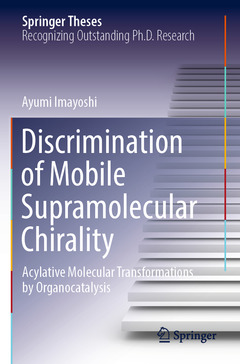Description
Discrimination of Mobile Supramolecular Chirality, 1st ed. 2022
Acylative Molecular Transformations by Organocatalysis
Springer Theses Series
Author: Imayoshi Ayumi
Language: English
Subject for Discrimination of Mobile Supramolecular Chirality:
Approximative price 179.34 €
In Print (Delivery period: 15 days).
Add to cartPublication date: 11-2022
87 p. · 15.5x23.5 cm · Paperback
Approximative price 179.34 €
In Print (Delivery period: 15 days).
Add to cartPublication date: 11-2021
Support: Print on demand
Description
/li>Contents
/li>Comment
/li>
Nominated by Kyoto University as an outstanding Ph.D. thesis
Presents a detailed description and a variety of examples of molecular transformations
Enables understanding of qualitatively novel asymmetric syntheses with a consistent concept evident throughout the book
These books may interest you

Chiral Photochemistry 74.82 €



